| dc.contributor.author | Barton, D. | nb_NO |
| dc.contributor.author | Rusch, G. | nb_NO |
| dc.contributor.author | Gjershaug, J.O. | nb_NO |
| dc.contributor.author | Faith, D.P. | nb_NO |
| dc.contributor.author | Paniagua, L. | nb_NO |
| dc.contributor.other | Barton, D. - Project manager | nb_NO |
| dc.coverage.spatial | | nb_NO |
| dc.coverage.temporal | 2003 | nb_NO |
| dc.date.accessioned | 2014-08-01T10:48:53Z | |
| dc.date.available | 2014-08-01T10:48:53Z | |
| dc.date.issued | 2004 | nb_NO |
| dc.identifier | 4856 | nb_NO |
| dc.identifier.isbn | 82-577-4539-1 | nb_NO |
| dc.identifier.issn | 1894-7948 | nb_NO |
| dc.identifier.uri | http://hdl.handle.net/11250/212484 | |
| dc.description | Årsliste 2004 | nb_NO |
| dc.description.abstract | The report is a companion to Barton, Faith et al. (2003) which motivates the use of the software TARGET for the prioritisation of biodiversity conservation payments on private land, or so-called “environmental service payments” in the Costa Rican context. The present report conducts an extensive sensitivity analysis for a number of variables that were deemed critical by managers reviewing initial TARGET results. Three different approaches to constructing the biodiversity indicators (attribute-based, PCA, and k-means) are followed, showing that the cost-efficient set of locations is most sensitive to this variable. The importance of the geographical scale and resolution of the environmental data for prioritisation of areas to receive payments is evaluated as these assumptions also implicitely define the comprehensiveness of the surrogate biodiversity indicator. Similarly, the generation of information on the opportunity cost of land-use for the whole study area is shown to be very sensitive to the GIS techniques used. Nevertheless, given an agreed set of assumptions on how to evaluate the existing georeferenced environmental and economic data – the TARGET algorithm provides quite robust and reliable sets of priority locations. | nb_NO |
| dc.description.sponsorship | Norwegian Research Council | nb_NO |
| dc.publisher | Norsk institutt for vannforskning | nb_NO |
| dc.relation.ispartofseries | NIVA-rapport;4856 | nb_NO |
| dc.rights | Navngivelse-IkkeKommersiell-DelPåSammeVilkår 3.0 Norge | nb_NO |
| dc.rights.uri | http://creativecommons.org/licenses/by-nc-sa/3.0/no/ | nb_NO |
| dc.subject | integrert vannforvaltning | nb_NO |
| dc.title | TARGET as a tool for prioritising biodiversity conservation payments on private land - a sensitivity analysis | nb_NO |
| dc.type | Research report | nb_NO |
| dc.rights.holder | Norsk institutt for vannforskning/Norwegian institute for water research | nb_NO |
| dc.subject.nsi | VDP::Matematikk og naturvitenskap: 400 | nb_NO |
| dc.source.pagenumber | 73 | nb_NO |
| dc.subject.keyword | target kostnadseffektivitetsanalyse | nb_NO |
| dc.subject.keyword | biomangfolds indikatorer | nb_NO |
| dc.subject.keyword | betaling for miljøtjenester | nb_NO |
| dc.subject.keyword | target cost-effectiveness analysis | nb_NO |
| dc.subject.keyword | biodiversity complementarity indicators | nb_NO |
| dc.subject.keyword | environmental service payments | nb_NO |
| dc.relation.project | O-23307 | nb_NO |


